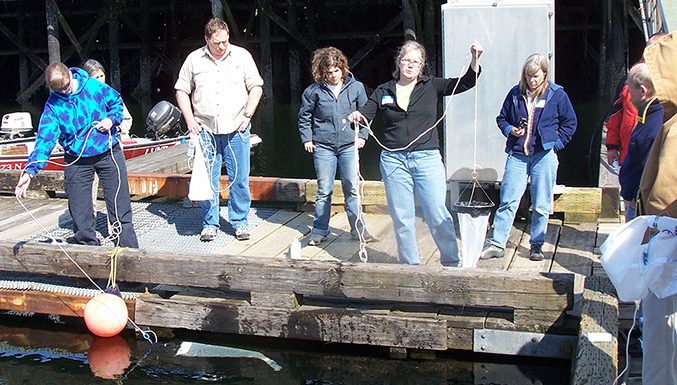Harmful algal blooms impact the coastal economy on average $82 million a year. Because every coastal state suffers HABs the problem is too much for any one agency. The National Phytoplankton Monitoring Network collects ecological data at low taxpayer expense in 36 states and territories. This is a true “citizen science” program that combines expertise from NOAA, state and federal agencies, and industry with the energy of volunteers from schools, universities and civic groups.
Why We Care
The National Phytoplankton Monitoring Network (PMN) is a community-based network of volunteers monitoring marine phytoplankton and harmful algal blooms (HABs). PMN recognizes the interrelationships between humans and coastal ecosystems while providing volunteer citizen scientists with meaningful opportunities for hands-on science engagement. The PMN enhances the Nation’s ability to respond to and manage the growing threat posed by HABs by collecting important data for species composition and distribution in coastal waters and creating working relationships between volunteers and professional marine biotoxin researchers.
What We Are Doing
- We train volunteer groups through workshops and on-line webinars on how to: collect samples, identify 26 species of phytoplankton using digital microscopy, and report their data to the NCCOS HAB Monitoring and Reference Branch using an on-line database.
- After we supply the groups with plankton nets, thermometers and salt refractometers, the groups start collecting and analyzing algae samples either weekly or biweekly.
- Volunteers preserve their samples and send them to the NCCOS Laboratory for confirmation and potential toxin determination. This is of particular importance when volunteers come across a species they do not recognize.
- PMN personnel notify state shellfish managers of blooms to serve as an early warning system of potential human health impacts.
Quality assurance and quality control of volunteer results is achieved using digital microscopy by members of the Marine Biotoxins Program. The NOAA Center for Coastal Monitoring and Assessment (CCMA) and NOAA Center for Operational Oceanographic Products and Services (CO-OPS) are notified about any blooms reported by volunteers. This assists the operation and validation (“ground-truthing”) of the HAB forecast.
Benefits of Our Work
Since 2001 PMN volunteers discovered over 500 blooms throughout coastal United States and have generated over 480,000 observations of environmental conditions. Volunteer data is directly incorporated into the state HAB monitoring plains of Texas, Mississippi, Alabama, Georgia, and South Carolina. HAB managers of other states are notified of potential blooms by PMN staff directly.
Next Steps
PMN will continue creating a sustainable monitoring program using new tools and user-friendly technologies developed under partnerships with smartphone app developers, NOAA NCDDC web mapping experts and built relationships with Olympus, Gano Technologies and Sea-Gear.

